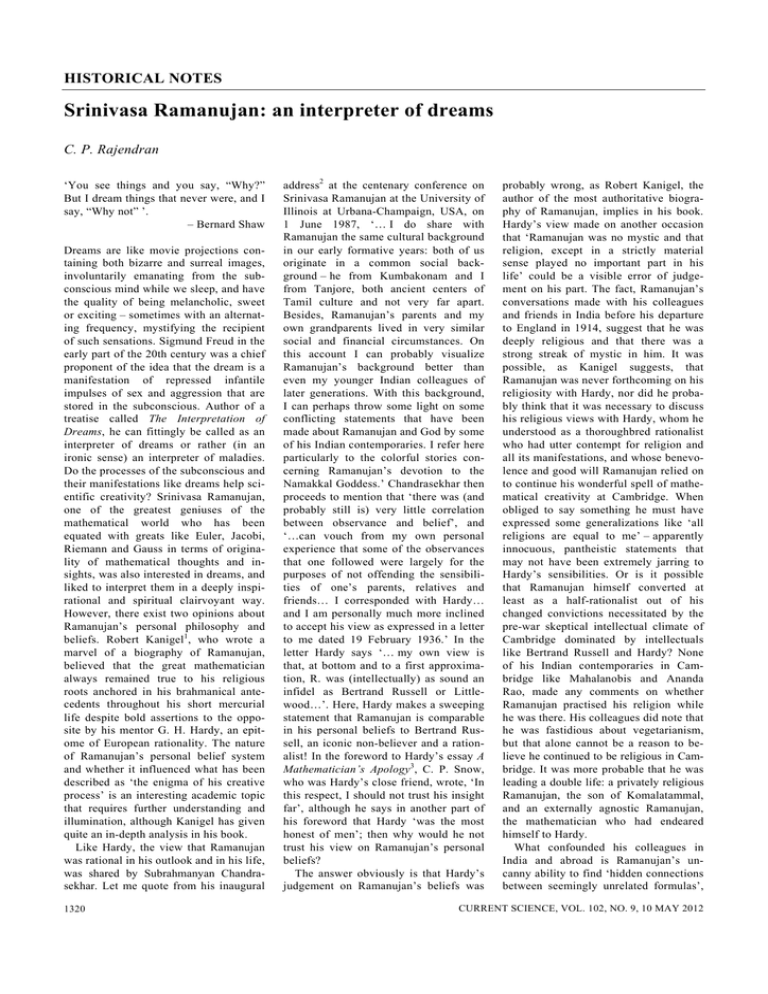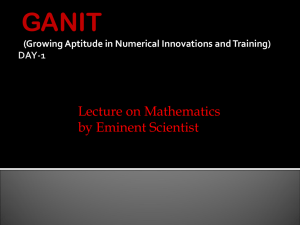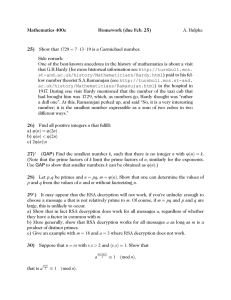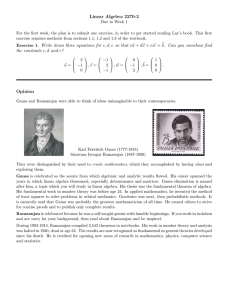Srinivasa Ramanujan: an interpreter of dreams HISTORICAL NOTES
advertisement

HISTORICAL NOTES Srinivasa Ramanujan: an interpreter of dreams C. P. Rajendran ‘You see things and you say, “Why?” But I dream things that never were, and I say, “Why not” ’. – Bernard Shaw Dreams are like movie projections containing both bizarre and surreal images, involuntarily emanating from the subconscious mind while we sleep, and have the quality of being melancholic, sweet or exciting – sometimes with an alternating frequency, mystifying the recipient of such sensations. Sigmund Freud in the early part of the 20th century was a chief proponent of the idea that the dream is a manifestation of repressed infantile impulses of sex and aggression that are stored in the subconscious. Author of a treatise called The Interpretation of Dreams, he can fittingly be called as an interpreter of dreams or rather (in an ironic sense) an interpreter of maladies. Do the processes of the subconscious and their manifestations like dreams help scientific creativity? Srinivasa Ramanujan, one of the greatest geniuses of the mathematical world who has been equated with greats like Euler, Jacobi, Riemann and Gauss in terms of originality of mathematical thoughts and insights, was also interested in dreams, and liked to interpret them in a deeply inspirational and spiritual clairvoyant way. However, there exist two opinions about Ramanujan’s personal philosophy and beliefs. Robert Kanigel1, who wrote a marvel of a biography of Ramanujan, believed that the great mathematician always remained true to his religious roots anchored in his brahmanical antecedents throughout his short mercurial life despite bold assertions to the opposite by his mentor G. H. Hardy, an epitome of European rationality. The nature of Ramanujan’s personal belief system and whether it influenced what has been described as ‘the enigma of his creative process’ is an interesting academic topic that requires further understanding and illumination, although Kanigel has given quite an in-depth analysis in his book. Like Hardy, the view that Ramanujan was rational in his outlook and in his life, was shared by Subrahmanyan Chandrasekhar. Let me quote from his inaugural 1320 address2 at the centenary conference on Srinivasa Ramanujan at the University of Illinois at Urbana-Champaign, USA, on 1 June 1987, ‘… I do share with Ramanujan the same cultural background in our early formative years: both of us originate in a common social background – he from Kumbakonam and I from Tanjore, both ancient centers of Tamil culture and not very far apart. Besides, Ramanujan’s parents and my own grandparents lived in very similar social and financial circumstances. On this account I can probably visualize Ramanujan’s background better than even my younger Indian colleagues of later generations. With this background, I can perhaps throw some light on some conflicting statements that have been made about Ramanujan and God by some of his Indian contemporaries. I refer here particularly to the colorful stories concerning Ramanujan’s devotion to the Namakkal Goddess.’ Chandrasekhar then proceeds to mention that ‘there was (and probably still is) very little correlation between observance and belief’, and ‘…can vouch from my own personal experience that some of the observances that one followed were largely for the purposes of not offending the sensibilities of one’s parents, relatives and friends… I corresponded with Hardy… and I am personally much more inclined to accept his view as expressed in a letter to me dated 19 February 1936.’ In the letter Hardy says ‘… my own view is that, at bottom and to a first approximation, R. was (intellectually) as sound an infidel as Bertrand Russell or Littlewood…’. Here, Hardy makes a sweeping statement that Ramanujan is comparable in his personal beliefs to Bertrand Russell, an iconic non-believer and a rationalist! In the foreword to Hardy’s essay A Mathematician’s Apology3, C. P. Snow, who was Hardy’s close friend, wrote, ‘In this respect, I should not trust his insight far’, although he says in another part of his foreword that Hardy ‘was the most honest of men’; then why would he not trust his view on Ramanujan’s personal beliefs? The answer obviously is that Hardy’s judgement on Ramanujan’s beliefs was probably wrong, as Robert Kanigel, the author of the most authoritative biography of Ramanujan, implies in his book. Hardy’s view made on another occasion that ‘Ramanujan was no mystic and that religion, except in a strictly material sense played no important part in his life’ could be a visible error of judgement on his part. The fact, Ramanujan’s conversations made with his colleagues and friends in India before his departure to England in 1914, suggest that he was deeply religious and that there was a strong streak of mystic in him. It was possible, as Kanigel suggests, that Ramanujan was never forthcoming on his religiosity with Hardy, nor did he probably think that it was necessary to discuss his religious views with Hardy, whom he understood as a thoroughbred rationalist who had utter contempt for religion and all its manifestations, and whose benevolence and good will Ramanujan relied on to continue his wonderful spell of mathematical creativity at Cambridge. When obliged to say something he must have expressed some generalizations like ‘all religions are equal to me’ – apparently innocuous, pantheistic statements that may not have been extremely jarring to Hardy’s sensibilities. Or is it possible that Ramanujan himself converted at least as a half-rationalist out of his changed convictions necessitated by the pre-war skeptical intellectual climate of Cambridge dominated by intellectuals like Bertrand Russell and Hardy? None of his Indian contemporaries in Cambridge like Mahalanobis and Ananda Rao, made any comments on whether Ramanujan practised his religion while he was there. His colleagues did note that he was fastidious about vegetarianism, but that alone cannot be a reason to believe he continued to be religious in Cambridge. It was more probable that he was leading a double life: a privately religious Ramanujan, the son of Komalatammal, and an externally agnostic Ramanujan, the mathematician who had endeared himself to Hardy. What confounded his colleagues in India and abroad is Ramanujan’s uncanny ability to find ‘hidden connections between seemingly unrelated formulas’, CURRENT SCIENCE, VOL. 102, NO. 9, 10 MAY 2012 HISTORICAL NOTES Ramanujan (in the middle) with his colleagues including Hardy (far right) in Trinity. which have been expressed as ‘supernatural insight’ or ‘as a gift from heaven’1. The irrepressible Hardy always insisted and demanded ‘proofs’ and rigour for the theorems that Ramanujan sent to him from India. In the initial stages of communications, Ramanujan’s avoidance to provide proofs often irritated Hardy. Ramanujan’s disinclinations were probably driven by his own incredulity of the unexpectedness and spontaneity of his solutions arrived through his mindboggling sense of knowing the result beforehand. The mystery surrounding Ramanujan’s unparalled mathematical insights and workings of his mind left many mathematicians perplexed. It is possible that the workings of his mind could have befuddled the owner himself and that he attributed his creativity to supernatural powers. In his spiritual world conditioned by his parents, it is only natural that the family deity, the Goddess at Namakkal, takes the place of the entity that he and his parents thought gave him that incredible power. Certainly, even if Ramanujan chose to discuss these matters with Hardy, he would not have understood any of this ‘Eastern mumbojumbo’. Kanigel puts this issue in a most impressive perspective: ‘Ramanujan’s belief in the Hindu gods, it stands repeating, did not explain his mathematical genius. But his openness to supernatural influences hinted at a mind endowed with slippery, flexible and elastic notions of cause and effect that left him receptive to what those equipped with more purely logical gifts could not see; that found union in what others saw as unrelated; that embraced before prematurely dismissing. His was a mind, perhaps, whose critical faculty was weak compared to its creative and synthetical.’1 Logic is seen here as only a way to structure ideas and not as a way to reach ideas that are breathtakingly fresh and of unanticipated variety. There were several great mathematicians who believed in the role of subconscious in reinforcing the mathematical creativity. For example, the book The Psychology of Invention in the Mathematical Field by the French mathematician Jacques Hadamard stresses ‘introspection’ to explain mathematical thought processes. He explains his own prowess in mathematics as ‘largely wordless’, and that the solution to a problem comes to him as mental images (visualizations). Other mathematicians like Gauss, Helmholtz, Riemann and Poincaré also viewed their thought processes in a similar fashion, and the solutions according to them occur with sudden spontaneity. The French mathematician and physicist Henri Poincaré, the harbinger of Einstein’s theory of special relativity, thought that ‘the distinguishing feature of the mathematical mind was not logical but aesthetic’. About Poincaré, a scholar says that he is ‘accustomed to neglecting details and to looking only at mountain tops and he went from one peak to another with surprising rapidity....’. Surprisingly, Hardy in his 1928 Cambridge lecture also uses the metaphor of mountain peaks in describing the mathematical creativity1. Ramanujan falls in the category of the above-mentioned mathematicians whose mental processes are dominated by unconscious acts of visualization, aesthetics, emotionality and spontaneity. CURRENT SCIENCE, VOL. 102, NO. 9, 10 MAY 2012 Anecdotes narrated by friends suggest that Ramanujan liked to interpret dreams. He used to say that in his dreams that god Narasimha helped him to see the ‘scrolls containing the most complicated mathematics…’1. In another instance, he told his friend that his interest in mathematics developed after a dream of ‘a peddler hawking pills’1. His ability to cut short the steps and by jaywalking to solutions probably extended to clairvoyance and astrological prophecies, which elevated him to the semi-status of a mystic in the Kumbakonam and Madras circles. Harvard psychologist Deirdre Barnett4 in her article in Scientific American Mind mentions that dreaming and subconscious activities help in solving problems that require visualization. She gives the example of Don Newman, a young mathematician at MIT in the 1950s and a contemporary of John Nash. Newman was once struggling to get a problem solved without success. He solved it through a dream during one night in which Nash appeared to explain the solution, which ultimately resulted in a paper. Barnett provides several other examples of scientists like Kekulé, who dreamed of the structure of benzene as a snake made of atoms thrusting its tail into its mouth. Mendeleev’s final form of the periodic table is a product of his dream. Otto Loewi dreamt of a neuroscience experiment that resulted in Nobel Prize in medicine4. According to Barnett, dreaming is thinking in a different biochemical state. She says that ‘dreams are bizarre and nonsensical … but help us to find solutions outside our normal patterns of thought.’ The dreamy state of mind allows one to see things with fewer 1321 HISTORICAL NOTES inhibitions and conjure up scenarios that are illogical and abnormal, and reach the solution the wrong way4. The new researches have shown that sleep during the rapid eye movement (REM) cycle and dreaming during that period are helpful to unleash mental powers to find intuitive solutions for difficult problems. Ramanujan may not be alone in ‘voyaging through strange seas of thought’, to restate Wordsworth, Nash’s genius is also in the same league, described as a person to see the vision first and constructing the proof later, whose flashes of intuition cannot be explained by rational methods, who is reported to have said during a psychiatric consultation that ‘the ideas about supernatural beings came to me the same way that my mathematical ideas did. So I took them seriously.’5 Taking the cue from Nash’s schizophrenic experiences, can we make some nuanced comparison to the Namakkal Goddess of Ramanujan, who was his archetypal provider of mathematical ideas in his dreams? Geniuses are of two varieties, ‘ones who are just like all of us, but very much more so, and the ones who apparently have an extra human spark. We can all run, and some of us can run the mile in less than 4 minutes.’ said Paul Halmos, another remarkable mathematician who argued that mathematics is a creative art and mathematicians are artists, probably restating what Hardy said in his ‘Apology’. Ramanujan’s mind belongs to a rare variety. We need to understand more about such mental powers without the crutches of supernaturalism. The new areas of research in cognitive psychology might be able to help us do that. A nation of one billion, I rarely hear anything new on this front from our country. But I am sure there may have been many Ramanujans who were born and died in India unknown for the want of a touch from a Midas like Hardy. And, that sensibility and unparallel intellectual audacity is a product of European rationality and enlightenment, making it possible for a dark-skinned matriculate at Madras Port Trust to get elevated as a fellow of Trinity College and the Royal Society. Here, we may probably want to ask a question to ourselves: Would any of our universities or science academies have had the courage to do such daring acts? By dint of luck, Ramanujan was born in a community that cherished education, and he fell into the sympathetic hands of a few friends and well-wishers in Madras who pooled their resources and connections to help him sustain his mathematics. Let me close this note by repeating what Jawaharlal Nehru said in his Discovery of India, which was first published in 1946: ‘Ramanujan’s brief life and death are symbolic of conditions in India. Of our millions how few get any education at all; how many live on the verge of starvation.’ Aren’t we still there? 1. Kanigel, R., The Man who Knew Infinity – A Life of the Genius Ramanujan, Macmillan Publishing Company, New York, 1991, p. 438. 2. Chandrasekhar, S., In Ramanujan Revisted, Academic Press, 1988, p. 1–6. 3. Hardy, G. H., A Mathematician’s Apology, Cambridge University Press, 2010, p. 153. 4. Barnett, D., Sci. Am. Mind, 2011, 27–32. 5. Nasar, S., A Beautiful Mind, Simon and Schuster, 1998, p. 619. C. P. Rajendran is in the Centre for Earth Sciences, Indian Institute of Science, Bangalore 560 012, India. e-mail: cprajendran@ceas.iisc.ernet.in Edited by P. Balaram, and printed & published by G. Madhavan for Current Science Association, Bangalore 560 080. Typeset by WINTECS Typesetters (Ph: 2332 7311), Bangalore 560 021 and Printed at Lotus Printers, Bangalore (Ph: 2320 9909) 1322 CURRENT SCIENCE, VOL. 102, NO. 9, 10 MAY 2012





